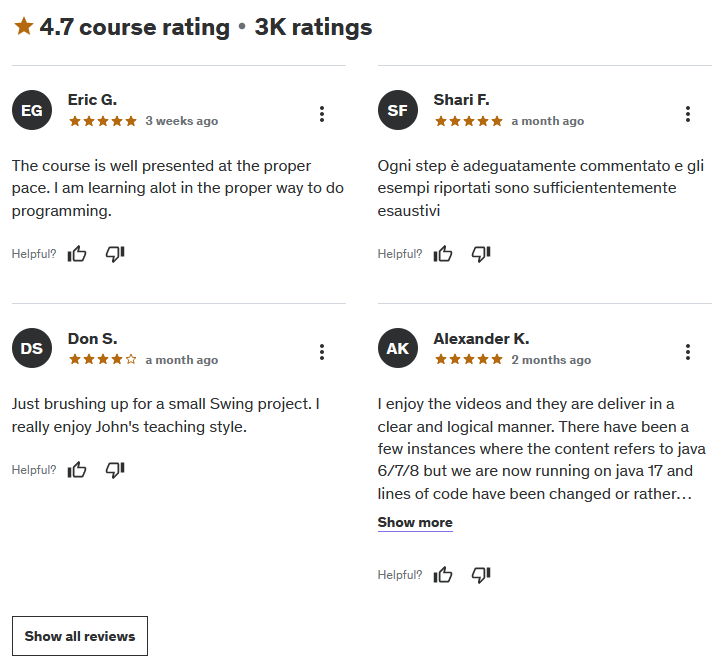In the ever-evolving world of Java programming, diving into GUI development can seem like a daunting task. However, John Purcell’s course, Java Swing (GUI) Programming: From Beginner to Expert, promises to demystify the complexities of creating desktop and Internet GUI Java programs. Let’s break down what this course has to offer, keeping it casual and straightforward.
First things first, this course is a hidden gem for those looking to polish their Java skills with some GUI sparkle. Whether you’re just stepping into the vast Java world or you’re a seasoned programmer aiming to expand your toolkit, this course has something for everyone.
Instructor Reputation
When we talk about online learning, especially in the realm of programming and software development, the instructor’s reputation can make or break a course. In the case of Java Swing (GUI) Programming: From Beginner to Expert, John Purcell stands as a towering figure whose credentials and teaching style bring an unparalleled depth to the learning experience.

John isn’t just another name in the vast sea of online instructors; he’s a beacon for those looking to navigate the complexities of Java programming. With an impressive instructor rating of 4.4 based on nearly 200,000 reviews, John’s courses have reached over 2.7 million students worldwide. This isn’t just a testament to his teaching abilities; it’s a reflection of the impact he’s had on the software development community.
Before stepping into the role of a full-time educator, John spent over 14 years working as a software developer and contractor for a myriad of companies across the UK and Netherlands, including notable names like CSC, Proquest, SPSS, and AT&T. This real-world experience is not merely a line on a resume; it’s the foundation of John’s teaching methodology. He brings practical, hands-on knowledge to the table, enriched by real challenges he’s faced in the field.
John’s journey didn’t stop at professional success; it took a more inspiring turn towards sharing his wealth of knowledge. After spending years in Budapest, Hungary, and Berlin, John now resides in Italy, continuing his mission to educate and inspire. His transition from a seasoned developer to a passionate educator is a story of dedication to software craftsmanship and a genuine desire to uplift others in their coding journey.
But what truly sets John apart is his approachable and engaging teaching style. He has a knack for breaking down complex concepts into digestible, easy-to-understand lessons. This skill is especially crucial when tackling a subject as intricate as Java Swing. John’s courses are not just a series of lectures; they are a dialogue with the student, designed to foster a deep understanding of the material.
Course Structure
Diving deeper into the course structure of Java Swing (GUI) Programming: From Beginner to Expert, it’s clear that John Purcell has meticulously designed this learning journey to cater to a wide audience. The course’s architecture is a thoughtful blend of comprehensive coverage and modular learning, allowing students to either dive deep into the entire course or pick and choose topics that interest them the most. This flexibility is particularly appealing in the vast and sometimes overwhelming field of programming.

The course kicks off with the basics of Java Swing, ensuring that even beginners without prior experience in GUI development can get up to speed. From there, it smoothly transitions into more complex concepts, such as Swing widgets, JDBC for database access, graphics API, and even touches upon model-view-controller (MVC) architecture. This gradual increase in complexity ensures that students are not thrown into the deep end without a lifeline.
What sets this course apart is the hands-on approach to learning. By building two complete applications step-by-step, students gain invaluable practical experience that solidifies their understanding of theoretical concepts. This project-based learning strategy is highly effective in reinforcing knowledge through application, making the learning process both engaging and rewarding.
Furthermore, the course delves into serialization for saving data, explores the listener-event model, and introduces basic animation techniques. These topics are not just randomly chosen; they are carefully curated to provide a well-rounded understanding of Java GUI programming. The inclusion of nearly all Swing widgets and a comprehensive look at JDBC for database access reflects the course’s aim to equip students with a robust toolkit for tackling real-world programming challenges.
Each tutorial within the course is designed to be self-contained, offering flexibility to students who may want to focus on specific areas of interest. However, the real magic happens when these tutorials are combined, painting a complete picture of Java Swing development. This structure supports a wide range of learning styles and paces, accommodating both rapid learners and those who prefer a more measured approach.
In essence, the course structure is a testament to John Purcell’s expertise and his understanding of the learning process. It’s not just about bombarding students with information; it’s about guiding them through a journey of discovery, one step at a time. The course is a carefully crafted roadmap, designed to take students from beginner to expert in Java Swing programming, with every module serving a specific purpose in the larger context of their learning journey.
Content Quality
The content quality of Java Swing (GUI) Programming: From Beginner to Expert is a critical aspect that sets it apart in the crowded field of online programming courses. John Purcell’s approach to content delivery is both comprehensive and deeply insightful, ensuring that students not only learn the mechanics of Java Swing but also understand the principles underlying GUI programming.

One of the course’s standout features is its clarity and logical progression. Each video tutorial is crafted with attention to detail, ensuring concepts are presented in a way that’s easy to grasp. The course meticulously covers the Java Swing framework, offering a deep dive into GUI components, layout managers, event handling, and more. This thoroughness ensures that learners come away with a solid foundation in Swing, capable of building sophisticated and responsive GUI applications.
However, the course’s content quality extends beyond just the tutorials. John’s teaching method involves a blend of theory and practical application, which is particularly effective in the realm of programming. The step-by-step construction of two complete applications not only cements the learning but also provides tangible outcomes that students can add to their portfolios. This hands-on approach, coupled with the detailed exploration of Swing widgets and JDBC for database access, enriches the learning experience, making the concepts more relatable and applicable.
The inclusion of advanced topics like the graphics API, MVC architecture, serialization, the listener-event model, and basic animation techniques further enhances the course. These sections are particularly valuable for students looking to push the boundaries of their Java GUI programming skills. By addressing these areas, the course ensures learners are well-prepared to tackle a variety of programming challenges, making them more versatile and marketable as developers.
Despite its many strengths, the course is not without its challenges. As some students have noted, references to older versions of Java can create moments of confusion, given the changes and updates in more recent versions. This aspect highlights a critical issue in programming education — the need for content to evolve alongside the technology. Nevertheless, this issue is somewhat mitigated by the course’s solid foundational teachings, which remain relevant across Java versions.
Overall Course Rating – 8.5/10
Taking everything into account — from the depth and breadth of the content covered to the instructional quality and practical application — Java Swing (GUI) Programming: From Beginner to Expert earns a solid 8.5 out of 10.

This is a robust and comprehensive course. It stands out not only for its thorough exploration of Java Swing but also for the way it nurtures a deeper understanding of GUI programming principles.
The course’s structured yet flexible approach allows learners of various skill levels to navigate the content according to their needs and interests. This adaptability, combined with the project-based learning strategy, ensures that students can apply what they learn in real-world scenarios, enhancing their skill set and confidence.
However, considering the feedback regarding the need for updates to reflect the latest Java versions, there is room for improvement. Keeping the course content current with technological advancements will enhance its value and relevance, ensuring learners are prepared for today’s programming challenges.
In conclusion, this is an excellent resource for anyone looking to delve into Java GUI development. Whether you’re a beginner eager to learn about Swing or an experienced programmer looking to refine your skills, this course offers a wealth of knowledge and hands-on experience that can help propel your programming career to the next level.



